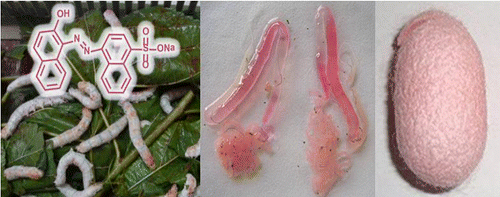Silkworms spin colored silks while on a 'green' dyed-leaf diet

For some 5,000 years, cultivated silkworms have been spinning luxurious white silk fibers destined for use in the finest clothing. But current dyeing practices produce wastewater that contains potentially harmful toxins, so scientists are turning to a new, "greener" dyeing method in which they coax already-colored fibers from the caterpillars by feeding them dyed leaves. Their findings are published in the journal ACS Sustainable Chemistry & Engineering.
Anuya Nisal, Kanika Trivedy and colleagues point out that dyeing textile fabrics is one of today's most polluting industries. The process requires huge quantities of water for bleaching, washing and rinsing, and it results in a stream of harmful wastewater that needs to be treated effectively before release into the environment. To make the industry greener and more environmentally friendly, researchers have been developing less toxic methods, including feeding dyed leaves to silkworms so they spin colored—rather than white—cocoons. But so far, this technique has only been tested with one type of dye, which is too pricey for large-scale production. Thus, the team turned to azo dyes, which are inexpensive and account for more than half of the textile dyes used today.
They dipped or sprayed mulberry leaves, the silkworm's food of choice, with azo dyes to see which ones, when consumed, would transfer to the silk. Of the seven dyes they tested, three were incorporated into the caterpillars' silk, and none seemed to affect the worms' growth. The scientists noticed that certain dye traits, such as the ability to dissolve in water, affected how well the dye worked. "These insights are extremely important in development of novel dye molecules that can be successfully used in this green method of producing colored silk fabrics," they conclude.
More information: Uptake of Azo Dyes into Silk Glands for Production of Colored Silk Cocoons Using a Green Feeding Approach, ACS Sustainable Chem. Eng., Article ASAP. DOI: 10.1021/sc400355k
Abstract
Dyeing of textile fabrics is considered to be one of the most polluting industries today, and there is a need to develop green processes that can reduce this pollution. A promising technology that can potentially cleanup the dyeing of silk fibers that are widely used for textile applications would involve the generation of intrinsically colored silk cocoons. This can be achieved by feeding of Bombyx mori silkworm larvae with a modified feed of mulberry leaves containing a sprayed dye solution. This process significantly reduces the need for treating toxic dye effluents that are generated in traditional dyeing processes. In this report, we have evaluated a set of seven different azo dyes that are used in the textile industry for dyeing to produce intrinsically dyed silk. The dyes used in the study had similar chemical structures with systematically varying partition coefficients. The results suggest that while some dyes produced intrinsically colored silk other did not. Careful evaluation of the physical properties of these related azo dyes suggest that the balance of hydrophobic and hydrophilic character is necessary for diffusion of the dye from the alimentary canal of the silkworm larva into the hemolymph and later into the silk glands. The partition coefficient of the dye also determines the preferential association of the dye with either sericin or fibroin protein in the silkworm gland and finally into the cocoon. These insights are extremely important in development of novel dye molecules that can be successfully fed to Bombyx mori silkworm larvae for producing intrinsically colored silk of various colors and shades.
Provided by American Chemical Society




















